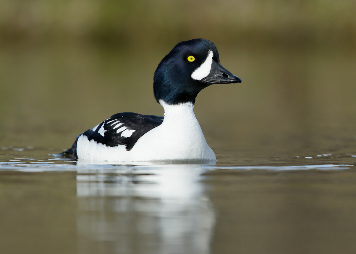Barrow's Goldeneye
Bucephala islandica (Gmelin, JF, 1789)
Photo © Iain H Leach
STATUS
Nearctic. Monotypic.
OVERVIEW
Species not admitted nationally during the period covered (BOU 1971).
NOT PROVEN
0) 1863 Yorkshire Mouth of the Derwent, female, shot, undated.
(D. Graham, Zoologist 1864: 9038-39; E. Newman, Zoologist 1864: 9122).
[T. Melling, British Birds 98: 230-237].
History David Graham of York (1864) in The Zoologist, 1st series, Vol. XXII. pp. 9038-39, dated 13th February, 1864, says: 'The following rare birds have occurred near here and have been sent to me for preservation: - A female specimen of Barrow's Goldeneye, shot at the mouth of the Derwent.'
[I feel very doubtful as to the names, but have done my best for them. - E.N.]
E. Newman, Editor (1864) in The Zoologist, 1st series, Vol. XXII. p. 9122, says: 'In printing Mr. Graham's communication (Zool. 9039) the locality where this bird was formerly obtained should be Iceland, not Ireland: there was not a single place of name or bird legibly written; I guessed at them as well as I could; but I must express a wish that correspondents would exercise a little more care in their MS.'
Comment Most records involved with David Graham are discredited over his involvement with the "Tadcaster Rarities" fraud (T. Melling, British Birds 98: 230-237). Not acceptable.
0) 1864 Lancashire & North Merseyside River Mersey, female, shot, undated.
(Newman, 1866).
[Not in BOU, 1971].
History Newman (1866: 121) says: 'In The Zoologist for 1864, at p. 9038, is recorded the occurrence of one of these ducks in the Mersey, by Mr. Graham, of York.'
Comments: Most records involved with David Graham are discredited over his involvement with the 'Tadcaster Rarities' fraud (T. Melling, British Birds 98: 230-237). Not acceptable.
0) 1911 Northumberland Holy Island, February, now at City of Stoke-on-Trent Museum.
(BOURC (1974), Ibis 116: 579).
[BOURC (1974), Ibis 116: 579].
History BOURC (1974) in The Ibis, Vol. CXVI. p. 579, stated that there was insufficient evidence to show that this bird had been obtained in Britain.
Comment Not acceptable.
0) 1913 Shetland Scalloway, Mainland, two, males, shot, 18th March.
(H. W. Ford-Lindsay, British Birds 7: 21-22; Venables & Venables, 1955).
[H. W. Robinson, Ibis 48: 631; Not in BOU, 1971; J. M. Collinson, Scottish Birds 25: 53-54].
History H. W. Ford-Lindsay (1913) in British Birds, Vol. VII. pp. 21-22, says: 'Regarding the very interesting article on the above (Vol. VI. p. 272-6) I had the pleasure of examining a couple of adult male Barrow's Goldeneye (Nyroca islandica) sent from Scalloway, in the Shetlands. They were forwarded to Mr. Bristow of St. Leonards, who kindly showed me the letter accompanying them, and afforded me every opportunity for examination. The birds were shot on March 18th, 1913, as Common Goldeneye (Nyroca c. clangula) and sent to Mr. Bristow as such. The first thing I noticed about them was the cresent shaped white patch on the side of the head, which as will be seen in the photograph is quite easily distinguished from the smaller, and round patch, in the Common Goldeneye. This is in itself enough to identify the bird when within shooting distance, and to my idea a valuable point, as it should save the wanton destruction of the Common Goldeneye, in the hope of obtaining the rarer species. Another striking contrast is the unbroken bar of white on the wing of the Common, which is broken in the two specimens of Barrow's. However it is hard to say, unless a number of specimens can be examined, to what extent these markings vary, and I must point out there are great differences in the two birds obtained by Mr. Bristow. In one of them there is far more white at the base of the neck than in the other, but it will be noticed that in the Common Goldeneye the white from the breast extends beyond the wing, whereas in the two specimens of Barrow's Goldeneye it does not reach beyond. Regarding the "boss" on the forehead, this was remarkably well developed in the two specimens I examined, and the scapular-feathers had the black portion of the rami elongated. But of course these last two facts could not be ascertained without being able to handle the birds.'
[There is no doubt that the birds are examples of Barrow's Goldeneye, the adult males of which are perfectly easy to distinguish, and could never be overlooked by anyone who knew the Common Goldeneye. The article referred to by Mr. Ford-Lindsay was written for the purpose of showing differences in the young males and females of the two species. We think that confirmatory records should be awaited before the species is fully admitted to the British List. - Eds.]
H. W. Robinson of Lancaster (1926) in The Ibis, Vol. LXVIII. p. 631, under 'On Recording Birds of Doubtful Authenticity as British,' says: 'The case of the two males of Barrow's Goldeneye (Bucephala islandica) said to have been shot in Scotland, and so labelled by the dealer who had them for sale, was another disgraceful case of forgery, yet many of this dealer's "discoveries" are given in most works as authentic, and the unfortunate part of it is that there are many. That there are honest dealers and taxidermists I grant, especially the bigger firms, yet the fact that most of the smaller ones are tempted by high prices to forge labels is a deplorable one.'
Comment Bristow was at the centre of the "Hastings Rarities" fraud (Nicholson & Ferguson-Lees, 1962). Not admitted (BOU 1971). Not acceptable.
